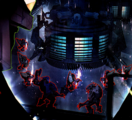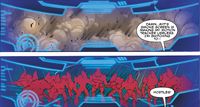Visual Intelligence System, Reconnaissance: Difference between revisions
From Halopedia, the Halo wiki
Lejellysoup (talk | contribs) mNo edit summary |
|||
| Line 26: | Line 26: | ||
==VISR database== | ==VISR database== | ||
[[File:VISR_Database.jpg|thumb|300px|The NAV parameter on the integrated VISR data management suite]] | [[File:VISR_Database.jpg|thumb|300px|The NAV parameter on the integrated VISR data management suite.]] | ||
The VISR database holds pertinent and relative information concerning battle to provide a distinct tactical advantage to the wearer. The database encompasses three main parameters situated in a carousel formation: | The VISR database holds pertinent and relative information concerning battle to provide a distinct tactical advantage to the wearer. The database encompasses three main parameters situated in a carousel formation: | ||
| Line 142: | Line 142: | ||
File:HEvol - SPI VISR.png|VISR mode integrated into the [[Semi-Powered Infiltration Armor|SPI Armor]]'s [[Heads-up display|HUD]]. | File:HEvol - SPI VISR.png|VISR mode integrated into the [[Semi-Powered Infiltration Armor|SPI Armor]]'s [[Heads-up display|HUD]]. | ||
File:H4 - Promethean Vision.png|VISR 4.0 used with the [[Promethean vision]] enhancement package. | File:H4 - Promethean Vision.png|VISR 4.0 used with the [[Promethean vision]] enhancement package. | ||
File:HE20-VISR-mode.jpg|VISR 4.0 utilized in ''[[Halo: Escalation]]'' | File:HE20-VISR-mode.jpg|VISR 4.0 utilized in ''[[Halo: Escalation]]''. | ||
</gallery> | </gallery> | ||
Revision as of 20:09, January 15, 2017
- "It's simple: If you see green, squad up. If you see red, shoot."
- — [1]
The Visual Intelligence System, Reconnaissance (VISR, pronounced "visor") is a proprietary integrated data management system used by UNSC personnel. It is incorporated into the helmets of Orbital Drop Shock Troopers and MJOLNIR GEN2, the latter of which features Version 4.0 of the suite.[2][3]
Overview
VISR provides tactical data in real time as it is broadcast. It can link into UEG, CAA, and UNSC infrastructure systems at the local, national, and global network levels, administered on a need or rating basis. The version of VISR issued to ODSTs near the end of the Human-Covenant War allows the user to store and review up to 610MB of content relevant to the current or all mission objectives.
Among other functions, VISR also provides navigational data and highlights various points of interest in the operational area. As of ODST BIOS update A29.817941B.01 it also features light enhancement systems, raising the brightness of the surrounding area on the user's heads-up display during low-light operations. VISR's low-light vision enhancement also links with the user's neural interface to provide Friend or Foe designation by searching for IFF transponders on friendly or enemy personnel. Enemy and friendly personnel and matériel are highlighted with different colors. Friendly combatants are highlighted in green whereas enemy combatants are highlighted in red. Usable weapons, vehicles, and medical kits are highlighted in blue; other objects and structures are highlighted in orange; beacons and data terminals are highlighted in yellow.[4]
VISR's core technology was originally developed for the MJOLNIR Powered Assault Armor[5] and was field tested by Spartan-III Headhunters.[6] Unlike the visual interface system developed for the Spartans, the ODST VISR requires no neural interface.[5] With the introduction of MJOLNIR [GEN2], the VISR 4.0 suite is now utilized by Spartan-IVs. This version is more similar to previous incarnations of the MJOLNIR heads-up display than the one used by ODSTs, and the new BIOS firmware allows a modification to the suite with the Z-5080 Promethean vision module. As of 2558 the highest version number is 4.09, though several customized types are available to operators within the Spartan branch's Specialization wings.[3]
VISR database
The VISR database holds pertinent and relative information concerning battle to provide a distinct tactical advantage to the wearer. The database encompasses three main parameters situated in a carousel formation:
- Navigation (NAV) - As an ODST lacks a motion trackers in his HUD, the NAV component in the VISR database provides a far more dynamic integration of mapping systems than featured by a standard motion tracker. It is very similar to the TACMAP in all MJOLNIR suits. The NAV tab is possibly the most useful feature in the VISR database suite because it provides a complete bird's-eye view of the current area in a interactive schematic grid; more importantly, the NAV parameter also shows the enemy forces in their entirety within the proximity of the highlighted area. This property of the database makes it very useful for tactical situations where planning is a key element. One downside to the enemy position interface is that the NAV function does not identify enemies individually (such as by rank or species) -- they are all represented with the same red diamond. However, one may still discern which types of Covenant infantry are in the vicinity by the marker's relative movement speed. Additionally, the NAV function only previews enemy locations within the vicinity of the VISR operator. User-set NAV markers may be displayed using this feature. The compass is synced with this parameter of the VISR database, as waypoints and beacons show up as integrated icons within the direction in relation to their location.
- Intelligence (INTEL) - This parameter is a comprehensive listing of the current mission objectives. On the right-hand side, a picture depicting the user is shown along with a symbol denoting rank, as well as the name of the operator. Another useful feature of this component is to set a marker to the current objective location along with a brief description of what the objective entails. Both the description and marker are broadcast upon the user's HUD. Beacons generally represent current objectives.
- Communications (COM) - This component is rather simplistic in its design and function.
There are other elements within the VISR database include the following:[7]
- Compass (integral with all factors regarding location, designation, and direction)
- Key locations (pre-placed beacons for mission objectives)
- Map legend (shown for all map elements)
- Grenade inventory (integrated with HUD)
- VISR database tabs (in carousel formation)
- Weapons and ammunition (integrated with HUD)
- Waypoint list
- Interactive local map
Known VISR Variants
- Standard VISR 4.0 - Recruit
Manufacturer: Hannibal Weapon Systems
For all newly deployed SPARTAN-IV assets.[8] This software manages the Spartan's disparate sensor feeds, battlenet links, and suit diagnostic messages.[9]
- Improved VISR 4.02 - Solar
- Manufacturer: Materials Group
- For flare mitigation and control operations.[8]
- Improved VISR 4.03 - Cyan
- Manufacturer: Hannibal Weapon System
- For protracted survival methodology.[8] Too expensive to be universally deployed, this VISR hardware is protected against electromagnetic interference, shock and corrosive atmospheres.[9]
- Upgraded VISR 4.04 - Blindside
- Manufacturer: Imbrium Machine Complex
- For combat vindication reliance factor.[8] This VISR is frowned upon by UNSC staff officers, and sacrifices strategic situational awareness for improved performance in small-unit actions.[9]
- Upgraded VISR 4.05 - Frost
- Manufacturer: Lethbridge Industrial
- For range visibility in subzero conditions.[8] It has a integral climate module and multi-layer insulation that can function in extreme temperatures and exotic cryogenic atmospheres.[9]
- Enhanced VISR 4.06 - Sunspot
- Manufacturer: Acheron Security
- For fixed support and auxiliary efforts.[8] With its integral climate module and multi-layer insulation the Frost VISR assembly can function in extreme temperatures and exotic cryogenics atmospheres.[9]
- Improved VISR 4.07 - Verdant
- Manufacturer: Naphtali Contractor Corporation
- For heavy machine operation in the field.[8] It was updated to comply with the latest industrial cyberlink standards, as well as expanded support for legacy interfaces.[9]
- Enhanced VISR 4.08 - Midnight
- Manufacturer: Materials Group
- For spatial blackout during slipspace maneuvers.[8] Materials Group uses this VISR as the basis for their next-generation battlespace management software, but proper use requires significant technical expertise.[9]
- Maximized VISR 4.09 - Legendary
- Manufacturer: Materials Group
- For next-gen asymmetric warfare operability.[8] The Beta-5 Asymmetrical Action Group has adopted the Legendary VISR for their Spartan units, albeit with custom plugins developed by ONI's internal teams.[9]
- Customized VISR 4.0 - Wetwork
- Manufacturer: Lethbridge Industrial
- Optimized for WETWORK-class armor.[8]
- Customized VISR 4.0 - Operator
- Manufacturer: Naphtali Contractor Corporation
- Optimized for OPERATOR-class armor.[8]
- Customized VISR 4.0 - Pioneer
- Manufacturer: Acheron Security
- Optimized for PIONEER-class armor.[8]
- Customized VISR 4.0 - Pathfinder
- Manufacturer: Imbrium Machine Complex
- Optimized for PATHFINDER-class armor.[8]
- Customized VISR 4.0 - Engineer
- Manufacturer: Lethbridge Industrial
- Optimized for ENGINEER-class armor.[8]
- Customized VISR 4.0 - Stalker
- Manufacturer: Naphtali Contractor Corporation
- Optimized for STALKER-class armor.[8]
- Customized VISR 4.0 - Rogue
- Manufacturer: Hannibal Weapon System
- Optimized for ROGUE-class armor.[8]
- Customized VISR 4.0 - Tracker
- Manufacturer: Acheron Security
- Optimized for TRACKER-class armor.[8]
- Prototype VISR 5.0
- Manufacturer: Hannibal Weapon System
- The VANGUARD-class Mjolnir is field testing this VISR type.[10]
- Clockwork
- The Clockword VISR is a piece of technical art, appreciated as a masterwork of programming and engineering by the handful of AI and human experts who understand the complexity of Mjolnir HUD design.[9]
- Envy
- The Envy VISR was developed by extreme sport enthusiasts on Mars. Through proven in environments far harsher than UNSC specifications required it took years to overcome anti-military sentiment in the boutique development house that made them.[9]
- Foucault
- The Foucault VISR represents a major policy shift in the UEG towards allowing smaller corporations to compete in the paramilitary, military, and security markets.[9]
- Vandal
- The Vandal VISR ensures when Spartans lose they do it in style and panache.[9]
Trivia

|
Browse more images in this article's gallery page. |
- When VISR is activated, Huragok writings are highlighted on walls around New Mombasa. They appear to be Covenant or Forerunner symbols. They commonly appear around dead Sangheili.
- The navigational database system in the VISR is similar to the TACMAP in both SPI and MJOLNIR armor systems.
- Anything using active camouflage (specifically, Brute Stalkers) will be highlighted in orange by the VISR. This means that the system identifies cloaked objects as scenery.
Gallery
VISR mode in Halo: Helljumper.
VISR 4.0 used with the Promethean vision enhancement package.
VISR 4.0 utilized in Halo: Escalation.
List of appearances
- Halo: Helljumper (First appearance)
- Halo 3: ODST
- Halo: Evolutions - Essential Tales of the Halo Universe
- Halo 4
- Halo: Escalation
- Halo: Nightfall
Sources
- ^ Bungie.net: "Feet First" Update
- ^ Halo 4 Official Site: Gameplay
- ^ a b Halo 4 - All 17 Visor Colors, Master Chief Helmet & Grifball!
- ^ Bungie.net: Halo 3: ODST Project Page
- ^ a b Halo Waypoint, VISR
- ^ Halo: Evolutions - Essential Tales of the Halo Universe, "Headhunters", page 164
- ^ UNSC Field Operations Guide (Halo 3: ODST Instruction Manual), page 8-9
- ^ a b c d e f g h i j k l m n o p q Halo 4 - Armory
- ^ a b c d e f g h i j k l Halo 5: Guardians - Armory
- ^ Halo 4: The Essential Visual Guide - Page 167




